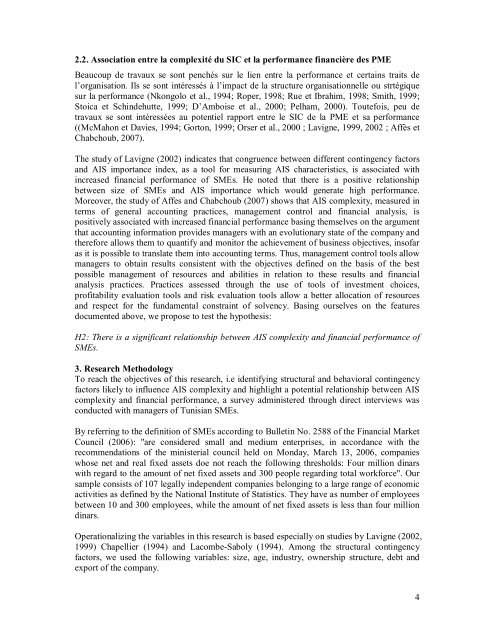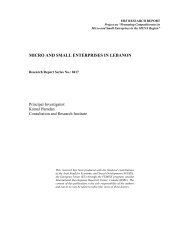2. Conceptual framework and research hypotheses2.1. Determinants <strong>of</strong> AIS complexity <strong>of</strong> <strong>SMEs</strong>Studies on the relationship between organizational specificities <strong>of</strong> a company and itscharacteristics allow to note that in the context <strong>of</strong> large public companies, all studies adoptedas a theoretical foundation the "positive theory" <strong>of</strong> Watts and Zimmerman (1978) . For <strong>SMEs</strong>,the theoretical underpinnings are not the same because the authors interested in this type <strong>of</strong>accounting firms (Chapellier 1994; Saboley-Lacombe, 1994; Lavigne, 1999, 2002, Orser et al.(2000); Affes and Chabchoub, 2007) take as the basis <strong>of</strong> their research, on the one hand, thesubjective and objective contingency theoryaccording to which AIS, which is part <strong>of</strong>organizational structure, is conditioned by the characteristics <strong>of</strong> the context in which thecompany operates and on the other hand, agency theory.In his study, Chapellier (1994) notes that in relation to <strong>SMEs</strong>, structural contingency factorscan be reduced to a few basic characteristics that refer to concepts <strong>of</strong> complexity anduncertainty. Indeed, the size and age <strong>of</strong> the company, the level <strong>of</strong> computerization <strong>of</strong>management, nature <strong>of</strong> business, ownership structure and debt are determinants <strong>of</strong> AIScomplexity. However, the results confirm only the relationship between size and accountingpractices. Lavigne (1999) meanwhile demonstrates, through a questionnaire survey, thatmedium-sized companies have a more complex AIS than those small and very small-sizedcompanies. Likewise, ownership structure is an important determinant <strong>of</strong> general accountingpractices for <strong>SMEs</strong> due to the presence <strong>of</strong> shareholders who are not members <strong>of</strong> the family <strong>of</strong>the manager. This is likely to encourage greater formalization in the preparation <strong>of</strong> financialinformation in order to solve agency problems and asymmetric information where AIS is amechanism <strong>of</strong> monitoring tools.The structural approach to contingency theory is instructive but some authors stress that it isinsufficient to explain all accounting practices <strong>of</strong> <strong>SMEs</strong> (Gordon and Miller 1976; Lavigne1999; Chapellier 1994; Affes and Chabchoub 2007 , Santin and Van Caillie 2008) and it isnecessary to broaden the approach by integrating an objective analysis <strong>of</strong> variables related tothe type <strong>of</strong> the pr<strong>of</strong>ile <strong>of</strong> each accounting player <strong>of</strong> <strong>SMEs</strong>: This is the behavioral approach <strong>of</strong>contingency theory. This most <strong>of</strong>ten revolves around the central player in the SME; themanager. The entire literature agrees to emphasize that the manager’s pr<strong>of</strong>ile (competence,history, culture, family, etc..) plays a very special role which justifies the specificity <strong>of</strong> thistype <strong>of</strong> organization as the manager is both producer and user <strong>of</strong> accounting information.Three other players, however, were identified as likely to influence accounting practices <strong>of</strong><strong>SMEs</strong>: the internal accountant (Chapellier 1994, Lavigne 1999), the external accountant(Chapellier 1994, Lavigne 1999) and the main external actor who is <strong>of</strong>ten a financialinstitution (Lavigne 1999; Saint Pierre and Bahri 2000).Chapellier (1994) shows associations between accounting practices and the followingbehavioral determinants: formation and goals <strong>of</strong> the manager, the mission and training <strong>of</strong>internal accountant and involvement <strong>of</strong> the external accountant. Lavigne (1999) identifieslinkages between general accounting practices and the following behavioral contingencyfactors: information preferences <strong>of</strong> the manager, the mission and training <strong>of</strong> internalaccountants and demands <strong>of</strong> external actors in relation to financial statements. Based on theresults <strong>of</strong> research and studies outlined above, we propose to test the hypothesis:H1: AIS complexity depends on structural and behavioral contingency factors.3
2.2. Association entre la complexité du SIC et la performance financière des PMEBeaucoup de travaux se sont penchés sur le lien entre la performance et certains traits del’organisation. Ils se sont intéressés à l’impact de la structure organisationnelle ou strtégiquesur la performance (Nkongolo et al., 1994; Roper, 1998; Rue et Ibrahim, 1998; Smith, 1999;Stoica et Schindehutte, 1999; D’Amboise et al., 2000; Pelham, 2000). Toutefois, peu detravaux se sont intéressées au potentiel rapport entre le SIC de la PME et sa performance((McMahon et Davies, 1994; Gorton, 1999; Orser et al., 2000 ; Lavigne, 1999, 2002 ; Affès etChabchoub, 2007).The study <strong>of</strong> Lavigne (2002) indicates that congruence between different contingency factorsand AIS importance index, as a tool for measuring AIS characteristics, is associated withincreased financial performance <strong>of</strong> <strong>SMEs</strong>. He noted that there is a positive relationshipbetween size <strong>of</strong> <strong>SMEs</strong> and AIS importance which would generate high performance.Moreover, the study <strong>of</strong> Affes and Chabchoub (2007) shows that AIS complexity, measured interms <strong>of</strong> general accounting practices, management control and financial analysis, ispositively associated with increased financial performance basing themselves on the argumentthat accounting information provides managers with an evolutionary state <strong>of</strong> the company andtherefore allows them to quantify and monitor the achievement <strong>of</strong> business objectives, ins<strong>of</strong>aras it is possible to translate them into accounting terms. Thus, management control tools allowmanagers to obtain results consistent with the objectives defined on the basis <strong>of</strong> the bestpossible management <strong>of</strong> resources and abilities in relation to these results and financialanalysis practices. Practices assessed through the use <strong>of</strong> tools <strong>of</strong> investment choices,pr<strong>of</strong>itability evaluation tools and risk evaluation tools allow a better allocation <strong>of</strong> resourcesand respect for the fundamental constraint <strong>of</strong> solvency. Basing ourselves on the featuresdocumented above, we propose to test the hypothesis:H2: There is a significant relationship between AIS complexity and financial performance <strong>of</strong><strong>SMEs</strong>.3. Research MethodologyTo reach the objectives <strong>of</strong> this research, i.e identifying structural and behavioral contingencyfactors likely to influence AIS complexity and highlight a potential relationship between AIScomplexity and financial performance, a survey administered through direct interviews wasconducted with managers <strong>of</strong> <strong>Tunisian</strong> <strong>SMEs</strong>.By referring to the definition <strong>of</strong> <strong>SMEs</strong> according to Bulletin No. 2588 <strong>of</strong> the Financial MarketCouncil (2006): "are considered small and medium enterprises, in accordance with therecommendations <strong>of</strong> the ministerial council held on Monday, March 13, 2006, companieswhose net and real fixed assets doe not reach the following thresholds: Four million dinarswith regard to the amount <strong>of</strong> net fixed assets and 300 people regarding total workforce". Oursample consists <strong>of</strong> 107 legally independent companies belonging to a large range <strong>of</strong> economicactivities as defined by the National Institute <strong>of</strong> Statistics. They have as number <strong>of</strong> employeesbetween 10 and 300 employees, while the amount <strong>of</strong> net fixed assets is less than four milliondinars.Operationalizing the variables in this research is based especially on studies by Lavigne (2002,1999) Chapellier (1994) and Lacombe-Saboly (1994). Among the structural contingencyfactors, we used the following variables: size, age, industry, ownership structure, debt andexport <strong>of</strong> the company.4
- Page 1 and 2: ECONOMICDEVELOPMENTAND THE RISEOF I
- Page 3: Rarely explored in Tunisia, AIS the
- Page 7 and 8: Invest Ratio Value ,467 4,882* 7,76
- Page 9 and 10: Prof.RatioRiskRatio.Value 2,552 1,6
- Page 11 and 12: Finally, the test shows that AIS co
- Page 13 and 14: accountant on strategic decisions a
- Page 15 and 16: We notice that as we add a variable
- Page 17 and 18: We notice in the fourth model that
- Page 19 and 20: managerand 29 yearsbetween 30and 39
- Page 21 and 22: Table 14: Results of normality of r
- Page 23 and 24: AFFES, H., CHABCHOUB, A., (2007),
- Page 25 and 26: SATHE, V., (1975),«Contingency The

















